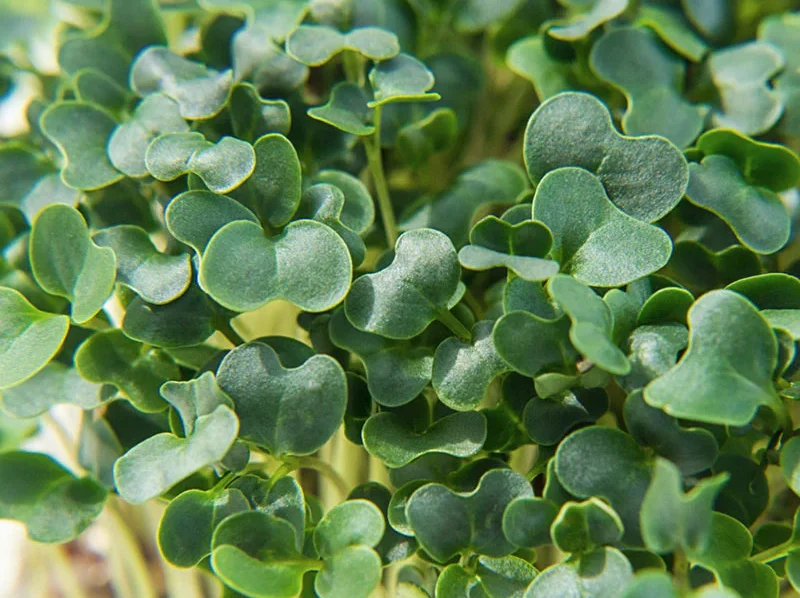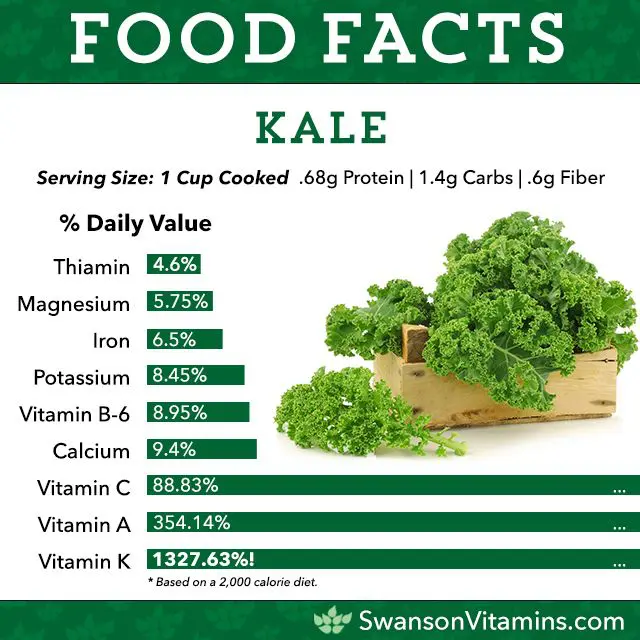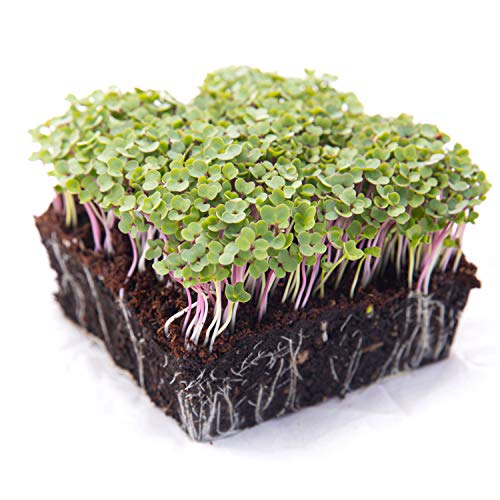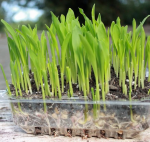This post contains affiliate links. If you buy something from one of our links we may earn a commission. Thanks

Looking to add some nutrient-rich kale microgreens to your next salad? In this blog post, we will teach you how to grow kale microgreens in just 7 easy steps.
Key Takeaways
• Growing Kale Microgreens is simple. Select a kale variety, then fill a tray with soil or use a coco coir grow mat.
• Spread 2-3 tablespoons of seeds on the soil, lightly cover with more soil, and water gently.
• Keep the tray in a bright area and water regularly. In 7-10 days, they’ll sprout, and in 2-3 weeks.
• When they are 2-3 inches tall, they are ready to be harvested. Enjoy these nutritious microgreens in various dishes.
Kale microgreens are a great way to get more vitamins and minerals into your diet, and they are also very tasty. They can be added to salads, sandwiches, or even smoothies. So let’s get started.
What Is Kale?
Kale is a member of the cabbage family and is a green, leafy, cruciferous vegetable that is rich in nutrients. It is a member of the mustard or Brassicaceae family and it is loaded with powerful antioxidants.
Kale, or leaf cabbage, belongs to a group of cabbage (Brassica oleracea) cultivars grown for their edible leaves, although some are used as ornamentals. Kale plants have green or purple leaves, and the central leaves do not form a head (as with headed cabbage). Kales are considered to be closer to wild cabbage than most of the many domesticated forms of Brassica oleracea. https://en.wikipedia.org/wiki/Kale
Kale Varieties
There are three main kinds of kale:
• Curly kale has bright green leaves that can be tightly curled. This is what most people think of as kale. The flavor can be peppery and bitter. Blue Scotch kale is a popular variety of curly kale.
• Tuscan kale has long, spear-like leaves that are dark green and have a pebbled texture. It is also called dinosaur kale. The flavor is earthy and less bitter than curly kale.
• Russian Red kale has flat fringed leaves that look like oak leaves. It has mild sweet leaves with a bit of pepperiness.
I have only grown the standard curly kale but I really want to give Russian Red kale a try.
Microgreens Seeds
 Kale microgreen seeds are among the most popular varieties of microgreen seeds, and for good reason – they are an excellent source of nutrition and have a lot of health benefits.
Kale microgreen seeds are among the most popular varieties of microgreen seeds, and for good reason – they are an excellent source of nutrition and have a lot of health benefits.
Not only do they contain a wide array of vitamins, minerals, and antioxidants, but they also possess anti-cancer properties due to compounds like sulforaphane and kaempferol.
Kale microgreens are incredibly easy to grow too In just a few short weeks after planting, you can begin to enjoy crunchy, fresh greens brimming with flavor.
Microgreens grown from kale seeds make for delicious salads and hearty soups alike, adding a delightful bite to any meal.
Whether you’re looking for something nutritious or simply searching for a new ingredient to spice up your kitchen creations, kale microgreens should be at the top of your list.
Kale Microgreens Taste
Kale microgreens have an amazing taste that is distinctive and full of flavor. This flavorful little vegetable packs a mighty punch, with a bold, sweet taste that conveys both nuttiness and a hint of spice.
It is often used in salads and as a garnish, but can also be enjoyed raw as an energizing snack. Kale microgreens have a unique texture – the leaves are thick and crunchy and the stems are juicy yet tender.
I would describe the taste as definitely cabbage-like with some sweetness and a bit peppery. You can definitely tell it is a brassica.
They provide several nutritional benefits too; for example, they are packed with vitamins C and A, along with minerals like magnesium, calcium, and iron. Overall, kale microgreens bring quite a burst of flavor to any dish.
How To Grow Kale Microgreens (7 Easy Steps.)
Just follow this easy step-by-step guide to grow your own kale microgreens.
1. Choose the right type of kale for your own microgreens. There are several varieties of kale available, but some of the most popular for growing microgreens include Tuscan kale, Red Russian kale, and curly kale. Choose whichever one you prefer.
2. Purchase or make your own potting soil mix with high-quality organic compost and perlite. I recommend using coconut coir as a growing medium in your growing tray. This will provide optimum germination rates for your microgreens.
3. Prepare the container that you’ll be using to grow your microgreens by filling it with the potting soil mix. Make sure you leave enough space at the top for watering later on.
 Alternatively, you can use a coco coir grow mat and avoid using potting mix altogether. Here is more on coco grow mats.
Alternatively, you can use a coco coir grow mat and avoid using potting mix altogether. Here is more on coco grow mats.
It is best to use a tray with drainage holes that you can nest in a similar-sized tray. This will make it possible to bottom water your microgreens.
4. Spread out 2–3 tablespoons of kale seeds on top of the soil mix for your next step. Make sure you spread them out evenly and press them lightly into the soil. Then cover the seeds with a thin layer of potting soil to begin the germination process.
5. Water your kale seeds gently and consistently until they sprout, which will usually take about 7-10 days.
Be careful not to give them too much water but don’t let your baby kale plants dry out either.
Don’t use a humidity dome because it limits air circulation. Use a clean spray bottle instead to water them.
6. When the kale microgreens start to grow, move them to a sunny spot in your house or garden that receives at least 6 hours of direct sunlight each day. Keep them at room temperature which is 68–72 ° Fahrenheit.
Most of North America will not have enough light during the winter and indirect sunlight will result in leggy etiolated plants and lower yields so plan on using artificial light.
If you want to grow microgreens year round you will want to use an LED grow light if you need supplemental lighting.
7. Harvest your microgreens when they reach 2–3 inches tall, cutting just above the soil surface with scissors, a sharp knife, or kitchen shears. Enjoy.
Follow these easy 7 steps and you’ll have fresh, nutrient-rich kale microgreens in no time.
Disclaimer: I am not a physician and don’t play one on TV either. The material on this site is not a substitute for professional medical advice, diagnosis, or treatment. Always seek a physician’s advice before using any information you find on this website to treat or prevent any condition.
Kale Microgreens Benefits
Kale microgreens are an incredibly nutritious type of vegetable and there are many people excited about the health benefits of kale.
Kale is packed with vitamin C, calcium, and iron. In addition to providing essential vitamins and minerals, kale microgreen’s nutritional value also offers numerous other health benefits such as helping to lower cholesterol levels, reducing inflammation, and boosting immunity.
As if that wasn’t enough, they also contain various antioxidants which can help protect the body from a range of diseases.
Thanks to their mild flavor and crunchy texture, kale microgreens make for an easy and delicious way to incorporate more nutrition into your diet.
All in all, it’s no wonder why kale microgreens are often lauded for their impressive nutritional profile and health-promoting effects.
Kale Microgreens Nutrition

Kale microgreens are nutrition powerhouses: they are incredibly nutrient-dense, providing vitamins A and C, calcium, iron, and magnesium.
Kale microgreens can provide even more concentrated nutrition than their mature counterparts. In addition to being a great source of fiber and antioxidants, kale microgreens may also contain beneficial compounds like sulforaphane that could be used defensively against cancer cells.
Eating kale microgreens is a fantastic way to incorporate beneficial nutrition into your diet without compromising convenience or taste.
How To Eat Kale Microgreens
Kale microgreens are incredibly nutritious and packed with flavor, making them a great addition to your diet.
To enjoy this superfood, you can add them to salads, sandwiches, or even soup. Microgreens also make a unique garnish that goes great in smoothies and egg dishes just sprinkle them on top to give your meal an extra boost of nutrition.
If you want to experience kale microgreens’ full range of flavor and texture, you can sauté some up for a delicious side dish or snack.
However you choose to consume them, use these power-packed greens to upgrade any meal.
You can increase their shelf life by storing them in an open container topped with damp paper towels in your refrigerator.
Here is how to store microgreens.
How To Grow Kale Sprouts In A Jar
If you’re looking for an easy way to begin growing your own food at home, cultivating kale sprouts in a jar is an ideal way to get started.
All you’ll need is some good-quality kale seeds and a large enough canning jar with a ring that can be opened easily. Don’t use the lid itself.
Soak the kale seeds overnight in filtered water and then drain off the excess water.
Place the seeds into the jar and cover the jar with a damp paper towel or some cheesecloth before closing use the ring to hold the towel in place or you could use a rubberband instead.
For best results, keep them in an area that receives indirect light and make sure to rinse them daily for a day or two with fresh, filtered water.
In a few days, they will start to sprout. With just a little bit of effort, you can enjoy your own fresh sprouts in no time.
Kale Microgreens FAQ
Our FAQ section is designed to provide clear answers to common questions about growing and enjoying kale microgreens.
Whether you’re curious about the growing process, the health benefits, or how to enjoy them in your meals, we’ve got you covered.
Q. How long do kale microgreens take to grow?
A. Kale microgreens typically take about 2 weeks to grow. They can be harvested at 2 weeks but it is good to let the true leaves start to appear so you may want to wait for week three to harvest.
Even at 3 weeks, it is much faster than full-grown vegetables.
Q. Are kale microgreens good for you?
A. Yes. Kale microgreens are packed with vitamins A and C, calcium, iron, and magnesium, as well as antioxidants that can protect the body from diseases that are linked to a range of illnesses.
They are also a great source of fiber and sulforaphane, which has been shown to have cancer-fighting properties.
Q. What is the best way to eat kale microgreens?
A. Kale microgreens can be enjoyed in salads, sandwiches, soups, smoothies, egg dishes, and as a side dish or snack when sautéed. However you choose to enjoy them, kale microgreens are a great way to get more nutrition in your diet.
Q. Can I grow kale microgreens indoors?
A. Yes, you can grow kale microgreens indoors with the right supplies and growing conditions.
Growing them in a jar is an easy and convenient way to get started with indoor sprouting.
Soak the seeds in water and then drain them off about 12 hours later. Refill and rinse out a 2nd time after a few hours.
Don’t refill the jar after the second rinse. Cover the top of the jar with cheesecloth or any porous cloth. They need air to sprout well.
Just make sure the jar is large enough and place it in an area that receives indirect light. The seeds will start sprouting in a few days.
With a little bit of care, you can enjoy your own kale microgreens in no time.
Q. Does kale make a good microgreen?
A. Yes, kale makes a great microgreen. Thanks to its mild flavor and crunchy texture, it’s an easy and delicious way to incorporate more nutrition into your diet.
Plus, kale microgreens are incredibly nutrient-dense and high in chlorophyll, making them packed with vitamins and minerals. For these reasons, kale is one of the most popular microgreens to grow.
Q. Can I use kale seeds for microgreens?
A. Yes, you can use kale seeds to grow microgreens. Just make sure they have not been treated. Ideally, they are organic and non-GMO.
Kale is one of the most popular and widely available microgreen varieties. Its mild flavor and crunchy texture make it a great addition to salads, sandwiches, soups, egg dishes, and smoothies.
Q. How tall do kale microgreens get?
A. Kale microgreens typically grow to a height of 2-3 inches tall. At this height, they are ready to be harvested and enjoyed.
Be sure not to let them grow too long, as some varieties can start to become bitter tasting.
The best time to harvest is when the leaves first begin to form their second pair of true leaves.
After harvesting, you can store them in a loosely sealed container or plastic bag with holes in the refrigerator and they should stay fresh for up to two weeks. Enjoy your freshly grown kale microgreens.
Final Thoughts
When it comes to growing kale microgreens, there are many varieties that you can choose from. Different varieties of kale will have slightly different flavor profiles and may grow at different rates. Kale microgreens are easy to grow and can be harvested in just a few weeks, so you can experiment with a variety of varieties and see which ones you like best.
Kale microgreens are packed full of nutrition and the health benefits they provide are impressive. They contain high levels of vitamins A, C, and K, as well as important minerals like iron, calcium, magnesium, and potassium.
They are also high in antioxidants and contain beneficial amounts of omega-3 fatty acids. Eating kale microgreens regularly can help you meet your daily requirement for these vital nutrients.
Now that you know how to grow kale micro greens, why not get started today? Follow our 7 easy steps and you will be harvesting your own delicious kale microgreens in no time. Enjoy the health benefits of this tasty superfood and start reaping the rewards.
In conclusion, kale microgreens are an incredibly nutritious and versatile vegetable that can be enjoyed in a variety of ways.
The process of growing these nutrient-dense greens is easy and straightforward, making them great for beginner gardeners who want to quickly enjoy the benefits of homegrown food.
With their mild flavor and crunchy texture, kale microgreens make for an easy and delicious way to incorporate more nutrition into your diet. So don’t wait – start growing your own kale microgreens today.











